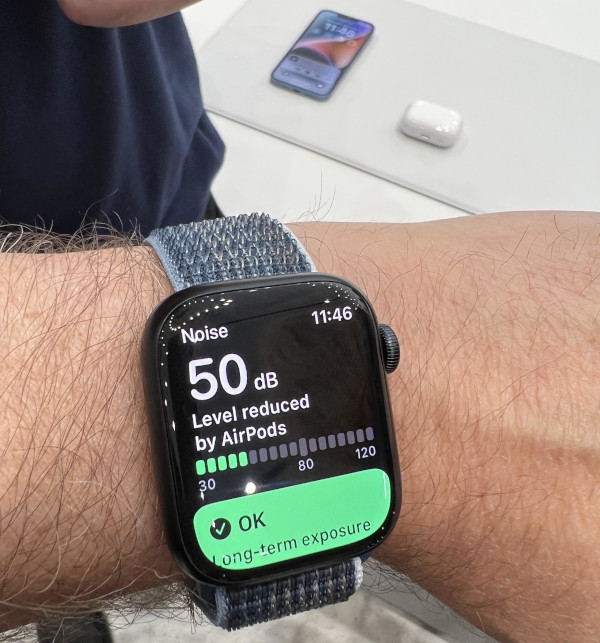I traveled to Apple Park to see the unveiling of the new iPhone 14 and Apple Watch models as well as the new AirPods Pro. This provided an opportunity for hands-on time with the earbuds, including a demonstration of their effectiveness in canceling out noise from around 700 excited journalists and social media influencers, all gathered around the new gear.
Apple boldly claims the new AirPods are the best sounding earbuds out there. While I’m sure that’s up for debate, the underlying message is that there is an improvement in sound quality that’s the result of hardware and software upgrades. Even the interchangeable ear tips play a role in optimizing sound quality, and Apple now includes an extra small size.
Battery life is 6 hours on a full charge with active noise cancellation or 7 hours with the device turned off. The charging case allows for multiple charges for 30 hours of noise-cancelling playback before you have to find a USB charger — or you can now use an Apple Watch charger to charge the case wirelessly. The case has a few other tricks up its sleeve, including a built-in speaker and a flashing LED light so you can find it even in a dark room. And it’s now possible to attach a lanyard to prevent further loss.

One of the most exciting new features of the AirPods Pro is custom spatial audio. The concept isn’t new: Sony and Creative Labs already use head and ear scans for personalized surround sound, but of course Apple has streamlined the process. Thanks to the iPhone’s 3D scanning function, it can collect the necessary biometric data to calculate an ideal profile for your ears. You can’t achieve the same level of immersion without the custom profile – it’s not as three-dimensional. However, hands-on impressions of custom spatial audio will have to wait for our full AirPods Pro review.
My brief hands-on managed to encompass spatial audio without the adjustment. What’s impressive is how effective the new AirPods were at deadening the noise in the room. Also, the new Apple Watch has a feature that shows exactly how much noise cancellation is being applied, so I could see I was getting 30-35dB of noise reduction. The difference was striking and the noise-cancellation now covers more than just bass frequencies and buzzing or droning noises like airplane engines – it’s also very effective on speech, so you really need the Transparency mode (just activate it via the touch-sensitive controls) to hear what someone is saying says.

Speaking of touch controls, the new AirPods Pro’s capacitive touch sensor lets you swipe the earbud’s signature stem to control the volume, with a haptic beep letting you know you’ve gradually adjusted it. I’ve tried it and it is indeed the most intuitive way to adjust the volume. While touch controls may be “better late than never” on the AirPods Pro, their implementation is seamless, as you’d expect from Apple.

The new AirPods Pro’s transparency mode is also getting a new feature that, if it’s as effective as Apple claims, could be a game changer. Adaptive transparency mode lets sound through but uses volume limiting to reduce excessively loud noise that could be harmful. Applications include hearing protection in the workplace, allowing you to hear sounds that warn you of danger and even hearing speech over machines. Or the new mode could be used to protect hearing at a loud concert without changing the character of the music like standard earbuds would.
The main question is how Apple’s new true wireless earbuds compare to their predecessors and the increasingly fierce competition. Check out our full review.
#Apple #introduces #AirPods #Gen #Custom #Spatial #Audio


Leave a Comment